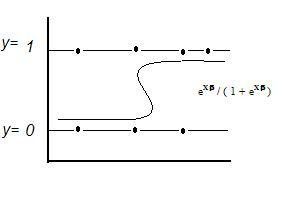Ordinary Least Squares:
OLS: y = XB + e
Minimizes the sum of squared residuals e'e where e = (y –XB)
R2 = 1- SSE/SST

OLS With a Dichotomous Dependent Variable: y = (0 or 1)

Dichotomous Variables, Expected Value, & Probability:
Linear Regression E[y|X] = XB ‘conditional mean(y) given x‘
If y = { 0 or 1}
E[y|X] = Pi a probability interpretation
Expected Value: sum of products of each possible value a variable can take * the probability of that value occurring.
If P(y=1) = pi and P(y=0) = (1-pi) then E[y] = 1*pi +0* (1-pi) = pi → the probability that y=1
Problems with OLS:
1) Estimated probabilities outside (0,1)
2) e~binomial var(e) = n*p*(1-p) violates assumption of uniform variance → unreliable inferences
Logit Model:
Ln ((Di /(1 – Di)) = βX
Di = probability y = 1 = eXβ / ( 1 + eXβ )
Where : Di / (1 – Di) = ’odds’
E[y|X] = Prob(y = 1|X) = p = eXβ / (1 + eXβ )

Maximum Likelihood Estimation
L(θ) =∏f(y,θ) -the product of marginal densities
Take ln of both sides, choose θ to maximize, → θ* (MLE)
Choose θ’s to maximize the likelihood of the sample being observed.Maximizes the likelihood that data comes from a ‘real world’ characterized by one set of θ’s vs another.

Estimating a Logit Model Using Maximum Likelihood:
L(β) = ∏f(y, β) = ∏ eXβ / (1 + eXβ ) ∏ 1/(1 + eXβ)
choose β to maximize the ln(L(β)) to get the MLE estimator β*
To get p(y=1) apply the formula Prob( y = 1|X) = p = eXβ* / (1 + eXβ*) utilizing the MLE estimator β*to'score' the data X.
Deriving Odds Ratios:
Exponentiation ( eβ ) gives the odds ratio.
Variance:
When we undertake MLE we typically maximize the log of the likelihood function as follows:
Max Log(L(β)) or LL ‘log likelihood’ or solve:
∂Log(L(β))/∂β = 0 'score matrix' = u( β)
-∂u(β)/ ∂β 'information matrix' = I(β)
I-1 (β) 'variance-covariance matrix' = cramer rao lower bound
Inference:
Wald χ2 = (βMLE -β0)Var-1(βMLE -β0)
Assessing Model Fit and Predictive Ability:
Not minimizing sums of squares: R2 = 1 – SSE / SST or SSR/SST. With MLE no sums of squares are produced and no direct measure of R2 is possible. Other measures must be used to assess model performance:
Deviance: -2 LL where LL = log-likelihood (smaller is better)
-2[LL0 - LL1] L0 = likelihood of incomplete model L1 = likelihood of more complete model
AIC and SC are deviants of -2LL, and penalize the LL by the # of predictors in the model
Null Deviance: DN = -2[LLN - LLp] LN = intercept only model Lp= perfect model ~ SST
Model Deviance: DK = -2[LLK - LLp] LK = intercept only model Lp= perfect model ~ SSR
Model χ2 : DN -DK For a good fitting model, model deviance will be smaller than null deviance, giving a larger χ2 and a higher level of significance.
Pseudo-r-square: DN -DK / DN Smaller (better fitting) DK gives a larger ratio. Not on (0,1)
Cox & Snell Pseudo R square: adjusts for parameters and sample size, not on (0,1)
Nagelkerke (Max-rescaled r-square) : transformation such that R --> (0,1)
Other:
Percentage of Correct Predictions
Area under the ROC curve:

Area = measure of model’s ability to correctly distinguish cases where (y=1) from those that do not based on explanatory variables.
y-axis: sensitivity or prediction that y = 1 when y = 1,
x-axis: 1-specificity or prediction that y = 1 when y = 0, false positive
References:
Menard, Applied Logistic Regression Analysis, 2nd Edition 2002
This is very clear and very helpful, thank you.
ReplyDeleteHi, I would like to understand more on the logistics function.
ReplyDeleteHow to apply it if I want to predict the mobile telephony market, i.e. I only have the data for number of subscribers.
Thank you!